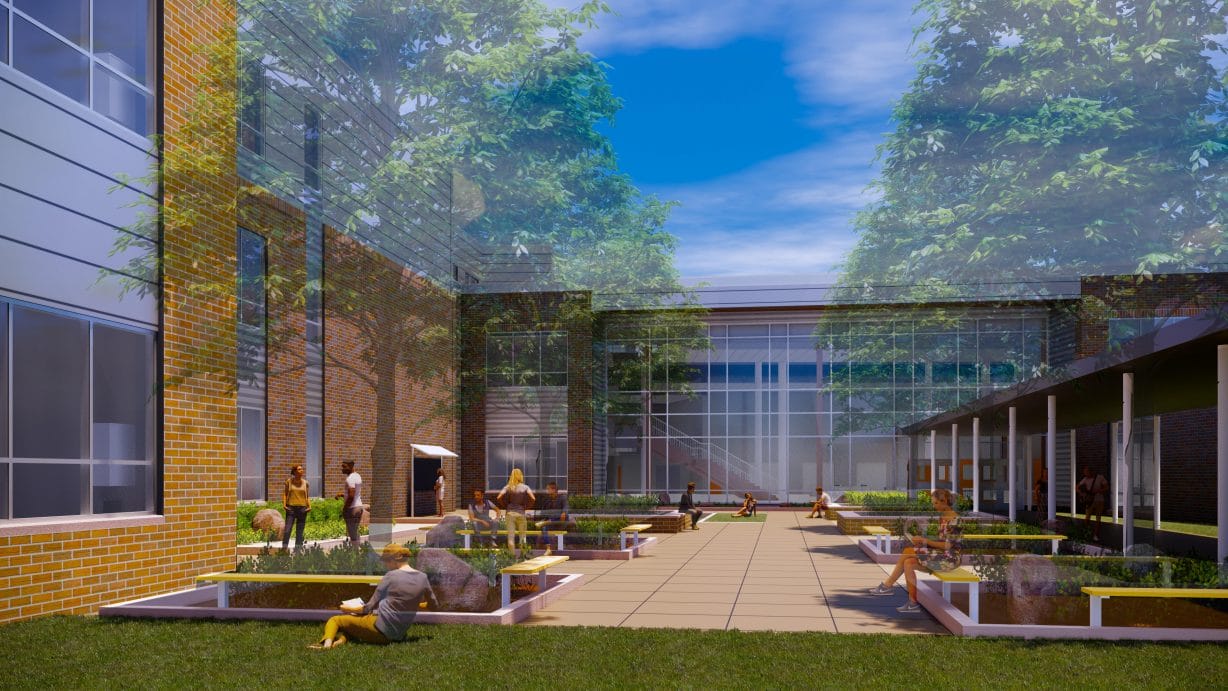
By Randi B. Hagi, assistant editor
A stadium complex will stay in the new high school design – for now.
The Harrisonburg School Board voted unanimously to approve the recommendations of the design committee that were presented in last month’s work session, cutting only a nearly quarter-million-dollar walkway canopy but keeping the nearly $5 million sports stadium complex after a split vote.
Now, the contractor, Nielsen Builders Inc., and architect, Grimm + Parker, will finish 60 percent of the final design documents and determine a “maximum guaranteed price,” which Superintendent Michael Richards said “will come in early November.” The last public estimate for the new school’s cost came in January and was $85.5 million, but that was before the board engaged in a contract with Nielsen and Grimm + Parker to simultaneously work on the project in what’s called a “design/build” approach.
Once a final cost is decided, the school board must approve that price, followed by the city council. Then Nielsen can break ground.
The board started with a motion Tuesday to accept the design committee’s recommendations for the new high school with the understanding that board members could propose amendments to remove various elements to save money.
Vice-chair Andy Kohen proposed the only two amendments. One was to remove the $237,000 canopy, which passed unanimously.
The other would have cut the nearly $5 million sports stadium complex. The board split 3-3, so the proposal didn’t pass. Kohen and board members Kaylene Seigle and Nick Swayne voted for the amendment to nix the stadium, while Deb Fitzgerald, the board chair, and board members Kristen Loflin and Obie Hill voted against the amendment.
“[Even] granting all the good things that would be available, I don’t think it would be worth spending $5 million on it,” Kohen said.
Brandon Burley, director of student activities at Harrisonburg High School, raised concerns at last month’s work session about trying to juggle the scheduling of events if both schools were to share the existing stadium at the current school.
In addressing that, Kohen said he was “very confident in the abilities of our folks in athletics” to navigate that.
“We know that it’s done elsewhere,” he said.
Swayne said the stadium could be built later if the community decides that “it is a necessity.”
“Our fundamental responsibility is to education, primarily,” Swayne said.
Hill, who voted to keep the stadium in the design, said “intelligence is not solely based solely” on academics.
“You have people who are musically gifted,” he said. “You have people who are kinetically gifted.”
Fitzgerald said she ultimately voted to keep the stadium complex after looking at the long-term picture.
“I changed my mind on this,” Fitzgerald said. “I think that if we can do it, we should.”
After the meeting, Fitzgerald told The Citizen that, when the new high school opens, each high school will have between 900 and 1,000 students, and each can grow to between 1,200 and 1,300 – which will require two sports stadiums.
“As the schools grow, almost certainly. And I don’t think it will ever be cheaper” to build, Fitzgerald said.
While Seigle voted against keeping the stadium in the design, during board discussion she reminisced about the local craze for high school football in the 1980s and 1990s.
“I love football,” she told The Citizen after the meeting. She recently attended a Harrisonburg High School Hall of Fame ceremony, in which some of her classmates who played in the 1990s were inducted.
“It just brought me back to when I did attend football games then … it just has changed,” Seigle said. “There’s been more concerns … healthwise, concerns about concussions, the effects of playing football.”
Also at the meeting:
- Kohen announced that the Harrisonburg Education Foundation, which is a nonprofit organization that raises and spends money to support the school district, has received about “a dozen” applicants for the executive director position to follow in the footsteps of current retiring director Zanetta Ford-Byrd.
- Richards said that 30 strategic planning process committee members will gather for a retreat from Oct. 16-18.
Editor’s note, Oct. 2, 2019: the director of the Harrisonburg Education Foundation had been erroneously identified as Diane Foucar-Szocki, who according to their website, is the Vice-chair of the Board of Directors.
Journalism is changing, and that’s why The Citizen is here. We’re independent. We’re local. We pay our contributors, and the money you give goes directly to the reporting. No overhead. No printing costs. Just facts, stories and context. Thanks for your support.














